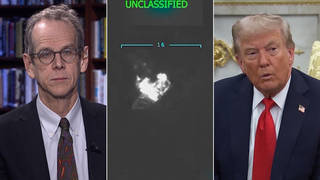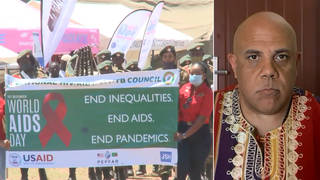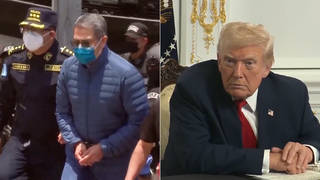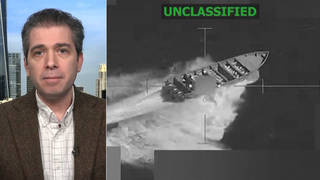
Topics
Guests
- Brenda Ekwurzelsenior climate scientist and director of climate science for the Climate and Energy Program at the Union of Concerned Scientists.
In California, tens of thousands of residents have been forced to evacuate as deadly wildfires continue to rage across the state. The worst wildfire, the Carr Fire, has engulfed more than 100,000 acres and destroyed more than a thousand homes in and around Redding, California, making it the sixth most destructive fire in the state’s history. Authorities said Wednesday that 16 of the largest wildfires burning in California have scorched 320,000 acres—an area larger than Los Angeles. Eight people have died. Governor Jerry Brown called the growing intensity and frequency of California wildfires the state’s “new normal” this week. More fires continue to consume parts of Colorado, Idaho, Oregon, Washington and Arizona, along with recent blazes across the globe in Greece, Canada and the Arctic Circle. We speak with Brenda Ekwurzel, senior climate scientist and director of climate science for the Climate and Energy Program at the Union of Concerned Scientists.
More from this Interview
- Part 1: Climate Scientist: California Wildfires Are Faster, Stronger, Deadlier & Will Continue to Intensify
- Part 2: Rob Nixon: Gov’t Inaction on Climate Change Is “Slow Violence” That Hits World’s Poor the Hardest
- Part 3: “Losing Earth”: How Humanity Came to Understand Climate Change & Failed to Act in Time
- Part 4: Extreme Weather Is Exploding Around the World. Why Isn’t the Media Talking About Climate Change?
Transcript
NERMEEN SHAIKH: We begin in California, where tens of thousands of residents have been forced to evacuate as deadly wildfires continue to rage across the state. The worst wildfire, the Carr Fire, has engulfed more than 100,000 acres and destroyed more than a thousand homes in and around Redding, California, making it the sixth most destructive fire in the state’s history. Authorities said Wednesday that 16 of the largest wildfires burning in California have scorched 320,000 acres—an area larger than the entire city of Los Angeles. Eight people have died in the fires so far. This is Cal Fire operations chief Steve Crawford describing the aggressive nature of this year’s wildfires.
STEVE CRAWFORD: Every single person that I’ve talked to so far has made the mention that “I don’t know why it’s doing what it’s doing. It’s burning differently. It’s burning more aggressive than it has in years past.” And I know we say that every year, but it’s unprecedented. … It’s burning in every direction all at the same time. And we’ve got—even though we have multiple resources, the way that it’s burning, the intensity that it’s burning, uphill, downhill, even if it doesn’t have a strong wind on it, it’s burning as if it’s got a Santa Ana wind or a strong 60-mile-an-hour, 70-mile-an-hour wind.
NERMEEN SHAIKH: Wildfires are also surging across other parts of the West. In Colorado, the third-largest fire in the state’s recorded history continues to grow near Garland in the southern part of the state. The Spring Fire has so far consumed more than a hundred homes and led to the evacuation of more than 2,000 people. In Washington, a wildfire dubbed the [Milepost] 90 Fire, had grown to some 11,000 acres by Wednesday. Fires also rage in Arizona, Idaho and Oregon.
AMY GOODMAN: The fires in the U.S. come amidst a month of deadly climate-fueled weather across the world. Seven fires remained active in the forests of northeastern Ontario, Canada, as of Wednesday, after days of efforts by the local firefighters to put out the raging fire. More than 50 fires burn across Sweden, including in Swedish Lapland inside the Arctic Circle. And in Greece, at least 90 people have died as uncontrollable wildfires swept through neighborhoods outside the capital Athens. The blazes were the worst fires in more than a decade. Christos Zerefos, a climate scientist at the Academy of Athens, explained [that] a combination of environmental factors created a perfect storm for the blaze to spread quickly in what was a lush, densely populated area.
CHRISTOS ZEREFOS: Well, it was definitely a high-risk zone. It was called a paradise, but, as we all have seen, a paradise to be lost. … There will be more common, more frequent extreme weather phenomena, because the climate globally is being destabilized. … That we have added a caution or an additional source of heat that is produced by humans, the burning of fossil fuels.
AMY GOODMAN: Climate scientists have linked increasingly scorching temperatures and deadly wildfires to climate change.
For more, we’re joined by Brenda Ekwurzel, senior climate scientist, director of climate science for the Climate and Energy Program at the Union of Concerned Scientists.
Welcome back to Democracy Now!, Dr. Ekwurzel.
BRENDA EKWURZEL: Good to be here.
AMY GOODMAN: Talk about what’s happening in California right now, what people are calling fire tornadoes, and this link to climate change.
BRENDA EKWURZEL: Well, what we know with climate change, one of the clearest signals is heat. And what we see is more occurrences of extreme heat. And when that happens during periods that are normally a drier time of season in a location or in places that are semi-arid, such as California has had multi-years of drought, this is the kind of toxic combination that can create very dangerous conditions, so that the wildfires are hotter, more severe and more dangerous for people living nearby dealing with the smoke, also if you are in the areas such as Greece or in areas that are fueled by Santa Ana winds that are much fiercer, stronger, blowing these fires at speeds that are very hard for people to escape.
AMY GOODMAN: Let’s go to California Governor Jerry Brown speaking at a news conference Wednesday about the fires raging across California.
GOV. JERRY BROWN: Yes, this is serious. Fires are now more a part of our ordinary experience. The predictions that things would get drier and hotter are occurring. And that will continue. We’re in quite a cycle, but the predictions that I see, that the more serious predictions of warming and fires to occur later in the century, 2040 or 2050, they’re now occurring in real time. And you can expect, unfortunately, that to keep intensifying in California and throughout the Southwest.
AMY GOODMAN: This has even become an issue in the governor’s race, of course, since it is so major as it sweeps through California, with the Republican candidate, John Cox, a climate change denier, saying it’s a waste of time to discuss these issues, we’ve just got to discuss readiness, versus Gavin Newsom, who has been championing the issue of dealing with climate change. Brenda Ekwurzel, what does climate change mean when you see it through this lens, when it comes to dealing with these massive crises, this term “fire tornadoes” that’s now being used?
BRENDA EKWURZEL: What we know is that, without a doubt, if you have hotter temperatures—it’s just basic physics—you evaporate more water from your lakes and rivers, and you’re drying out the soils. And the vegetation needs more water in these conditions, and it’s losing more water to the atmosphere. So you can create a tinderbox condition, if you happen have a natural lightning strike or a careless spark by human activity, causing a fire. So what we see in the Western U.S., that large wildfires are lasting longer, they’re more severe, and they are burning more acres.
The other consequence is that, as you said, the threat to—the dangerous situation for people living on the front lines of a wildfire situation, it’s putting more wildfire hotshots, as they’re called, who are bravely fighting these fires, their lives on the line, as well as people and property who are in the way of the fire. And that’s why we need very advanced science to warn people about the conditions over the long term and what we can do, and also, in the near term, in the fast warning systems to get people out of the way and heed these warnings. These fires are much faster and stronger than we’ve ever seen before. And that’s in part because of burning coal, oil and gas.
NERMEEN SHAIKH: Well, Brenda, we just heard the California governor saying—saying himself that these fires are likely to keep intensifying and increasing in the coming decades. So what steps do you think can be taken now? Are there any preventative steps that the state can take to prevent this from happening, or at least to mitigate it from happening?
BRENDA EKWURZEL: Luckily, Governor Brown has been a real leader in taking the state to reducing its own emissions of heat-trapping gases. So that has been the—first and foremost, the best situation. You have to lower the baseline conditions. Scientists call it a hot drought. And when it’s a hot drought, more dangerous conditions can result, such as wildfires. Water resources for drinking water and the agricultural sector are at risk.
So, that’s number one, honor the Paris climate agreement locally, within states, cities and countries around the world, who are trying to keep the globe to below 2 degrees Celsius above preindustrial. Number two, create a bigger fire perimeter of safe area around structures or cherished resources that we need to protect. Make sure that there’s a big distance between human activities and what’s called the wildland-urban interface. That is where we see a lot of fire activity starting. So we have to stop these fires from starting in the first place, unless under natural conditions. And thirdly, we have to protect people’s public health.
AMY GOODMAN: Talking about policy, the Trump administration has argued that increased fuel efficiency standards endanger the lives of drivers. Documents seen by the Associated Press show administration officials are preparing to argue more-fuel-efficient cars will cause drivers to spend more time behind the wheel, leading to more deaths on roads and highways, attacking the fuel efficiency standards of California. The significance of this?
BRENDA EKWURZEL: That’s counterintuitive, because every study shows that when we have fuel-efficient cars, we’re putting less carbon into the atmosphere, if they’re powered by fossil fuel and not a renewable fuel source. And that means cleaner air for Californians, for any city, for any area where you have ground-level ozone, because there are three ingredients for smog: fossil fuel volatile organic carbon or from vegetation such as forests—they can create that, as well—sunlight and hot temperatures. And as we warm the globe, we have this climate penalty with ground-level smog, because we create more of the smog because we have hotter temperatures during the day than we did a century ago.
NERMEEN SHAIKH: Brenda, can you say a little about the populations, the more vulnerable populations, that are impacted the most by these wildfires in California, and also elsewhere, the effects of climate change-induced environmental disasters on vulnerable populations?
BRENDA EKWURZEL: Sure. What we saw, for example, if you look at other parts of the world in the—when there was a combination of wildfire plus extreme heat in Russia, studies show that that was made possible more severe because of climate change, but the high mortality was the combination of smoke from these peat fires in the high northern latitudes and the high temperatures, combining to create a very dire health risk. And there were many tens of thousands of people that died.
Also, a study in 2003 heat wave, what we found—Stott and colleagues, scientists studying this heat wave, found that the double—the risk of this horrendously tragic heat wave, that lost the lives of tens of thousands of people, was doubled because of climate change. What we know is that a subsequent study, by Mitchell and Colleagues, that in central Paris, the heat mortality from that event was—70 percent of that excess heat mortality was due to human-induced climate change, and 20 percent of the heat mortality in London was due to human-induced climate change, in that 2003 tragic event.
AMY GOODMAN: We’re going to go to break, and we’re going to ask you to stay with us, Brenda Ekwurzel, senior climate scientist with the Union of Concerned Scientists, speaking to us—speaking to us from Boston. This is Democracy Now! When we come back—speaking to us from Washington, D.C. When we come back, we’ll continue this hour-long discussion. We’ll also be joined by Nat Rich, who has written the piece in The New York Times Magazine that is the entire magazine, only the second time in New York Times history that one article covers the entire magazine. The issue? Climate change. Stay with us.











Media Options